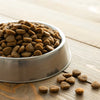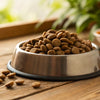Is It Better to Feed Dogs Wet or Dry Food? Exploring the Best Options for Your Furry Friend
- Houndsy
Table of Contents
- Introduction
- Understanding Dog Food Types
- Nutritional Content: Wet vs. Dry Food
- Factors to Consider When Choosing Dog Food
- The Best of Both Worlds: Mixing Wet and Dry Food
- Understanding Feeding Routines
- Conclusion
Introduction
Did you know that approximately 60% of pet owners are unsure about whether to feed their dogs wet or dry food? This common dilemma can be overwhelming, especially when you want the best for your furry companion. The dog food market is crowded with options, each promising to deliver the nutrients your pet needs. Understanding the differences between wet and dry dog food is essential for making an informed decision that caters to your dog’s unique requirements.
In this blog post, we will explore the key differences between wet and dry dog food, examine their benefits and drawbacks, and help you determine which option may be best for your beloved pet. By the end, you’ll have a clearer picture of how to enhance your dog’s daily feeding experience and ensure they receive the nutrition they deserve.
As we navigate through this topic, we invite you to reflect on your own pet feeding routines. Are you currently using wet food, dry food, or a mix of both? What challenges have you faced in maintaining a consistent and appealing feeding regimen for your dog? Let’s dive into the details to uncover the best practices for dog nutrition.
Understanding Dog Food Types
Before we delve into the specifics of wet and dry food, it’s essential to understand what each type encompasses.
Dry Dog Food (Kibble)
Dry dog food, often referred to as kibble, is a staple in many households. It is typically composed of grains, meat, and various vitamins and minerals, processed into small, hard pellets.
Advantages of Dry Dog Food
- Convenience: Kibble is easy to store and measure. It can be left out for dogs that prefer to graze throughout the day, and it doesn’t spoil as quickly as wet food.
- Dental Health Benefits: The texture of dry food encourages dogs to chew, which can help reduce tartar buildup and promote better dental hygiene.
- Cost-Effectiveness: Generally, dry dog food is more affordable than wet food, making it a budget-friendly option for pet owners.
- Variety: Kibble comes in various flavors and formulations, allowing you to choose a diet that suits your dog's specific needs.
Wet Dog Food (Canned)
Wet dog food, or canned food, has a higher moisture content than dry food, typically containing about 60-78% water. This type of food often has a richer aroma and flavor, which can make it more enticing for dogs.
Advantages of Wet Dog Food
- Higher Moisture Content: Wet food can help keep your dog hydrated, especially if they don't drink enough water throughout the day. This is particularly beneficial for dogs with certain health conditions, such as urinary or kidney issues.
- Palatability: Many dogs find wet food more flavorful compared to kibble, which can encourage picky eaters or older dogs with reduced appetites to eat.
- Easier to Chew: Wet food can be easier to chew for dogs with dental problems or those who may struggle with harder kibble.
- Increased Satiety: The moisture content can create a feeling of fullness, which may help with weight management.
Nutritional Content: Wet vs. Dry Food
When it comes to nutrition, both wet and dry dog foods can provide balanced diets. However, there are some differences to consider regarding their nutritional profiles.
Protein Sources
Both wet and dry foods can contain high-quality protein sources, such as chicken, beef, or fish. However, wet food often includes more meat by-products and may have a higher overall protein content due to its formulation.
Carbohydrates and Fillers
Dry dog food often contains grains such as corn and wheat, which serve as carbohydrates and fillers. Some pet owners prefer grain-free options, which can be found in both wet and dry formulations. Wet food, on the other hand, usually has fewer carbohydrates, as it focuses more on meat and moisture.
Additives and Preservatives
Dry dog food typically contains preservatives to extend shelf life, while wet food may rely on canning processes for preservation. Always check the ingredient list to ensure there are no harmful additives in your dog’s food.
Factors to Consider When Choosing Dog Food
When deciding between wet and dry dog food, several factors come into play. Here are key considerations to help guide your choice.
Your Dog's Age and Health
Puppies, adult dogs, and senior dogs have different nutritional needs. Consult your veterinarian to determine the best diet for your dog’s life stage and health status. For example, senior dogs may benefit from wet food due to its palatability and ease of chewing.
Hydration Needs
If your dog is a reluctant drinker, incorporating wet food into their diet can help boost their hydration. Conversely, if your dog drinks plenty of water and enjoys chewing, dry kibble may be the better option.
Lifestyle and Activity Level
Active dogs may require a higher caloric intake, which can often be met with dry kibble. If your dog tends to graze or is less active, wet food’s increased moisture content may help them feel full without consuming excessive calories.
Personal Preferences
Just as we have our preferences, so do our dogs. Some dogs may simply prefer the taste and texture of one type of food over the other. Experimenting with both options can help you find out what your dog enjoys most.
The Best of Both Worlds: Mixing Wet and Dry Food
Some pet owners find that a mixed feeding approach works best for their dogs. Combining wet and dry food can provide a balanced diet that includes the benefits of both types.
Benefits of Mixing
- Enhanced Flavor and Variety: Dogs often enjoy the combination of textures and flavors, which can make mealtime more exciting.
- Improved Hydration: Adding wet food to dry kibble can boost moisture intake, especially for dogs that don't drink enough water.
- Balanced Nutrition: A mixture can offer a well-rounded diet that caters to different nutritional needs and preferences.
How to Mix Effectively
When mixing wet and dry food, it’s essential to calculate the appropriate portions to avoid overfeeding. Consult your veterinarian to determine the daily caloric intake your dog requires, factoring in any treats or additional food.
Understanding Feeding Routines
Feeding routines can significantly impact your dog’s health and behavior. Establishing a consistent schedule can help regulate their eating habits and prevent overeating.
Recommended Feeding Practices
- Set a Schedule: Feeding your dog at the same times each day can create a routine that they will come to expect.
- Portion Control: Measure your dog's food to ensure they receive the right amount of nutrients without overindulging.
- Monitor Weight and Health: Regularly check your dog’s weight and adjust their diet accordingly. If you notice any changes in their eating habits or health, consult your veterinarian.
- Use Quality Products: At Houndsy, we believe in enhancing the dog feeding experience. Our flagship product, the Houndsy Kibble Dispenser, is designed to deliver perfect portions every time while seamlessly integrating into your home decor. Visit our Houndsy Kibble Dispenser product page for more information on how we can elevate your dog’s feeding ritual.
Conclusion
In the debate of wet vs. dry dog food, there is no one-size-fits-all answer. Both types offer unique benefits and can be tailored to fit your dog's specific needs. By considering factors such as your dog's age, health, hydration needs, and personal preferences, you can make an informed decision that enhances their daily feeding experience.
Whether you choose to feed your dog wet food, dry food, or a mixture of both, the goal remains the same: ensuring your furry friend receives the best nutrition possible. As you assess your feeding routine, consider incorporating the Houndsy Kibble Dispenser to simplify and elevate your feeding experience.
What type of food does your dog prefer, and have you noticed any changes in their health or behavior based on their diet? We’d love to hear about your experiences in the comments!
FAQ
Is it better to feed dogs wet or dry food?
Both wet and dry foods can provide balanced nutrition. The best choice depends on your dog’s individual needs, preferences, and health status.
Can I mix wet and dry dog food?
Yes! Mixing wet and dry dog food can offer a balanced diet with the benefits of both types. Just ensure you calculate the portions to prevent overfeeding.
How do I know what to feed my dog?
Consult your veterinarian for personalized recommendations based on your dog’s age, health, and lifestyle.
What are the benefits of wet food?
Wet food can improve hydration, palatability, and is easier to chew for dogs with dental issues. It may also help in weight management due to increased satiety.
What are the benefits of dry food?
Dry food is convenient, cost-effective, and can promote dental health through chewing. It also comes in various formulations that cater to different dietary needs.
How can I enhance my dog’s feeding experience?
Consider using the Houndsy Kibble Dispenser for perfect portion control and an elegant addition to your home. Check it out here.












